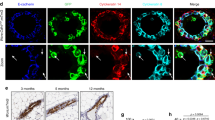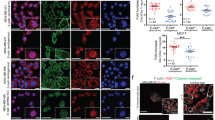Abstract
c-Myc oncoprotein is overexpressed in a significant proportion of human epithelial cancers, and experimental overexpression of c-Myc in epithelial cells promotes tumour formation. However, it is not known how c-Myc promotes epithelial cell tumour formation. We report that c-Myc expression in human mammary epithelial cells induces a dramatic change in cell morphology, with some characteristics of an ‘epithelial to mesenchymal transition’. E-cadherin expression is repressed by a post-transcriptional mechanism in cells expressing c-Myc. Furthermore, E-cadherin repression is necessary for c-Myc-induced cell transformation.
This is a preview of subscription content, access via your institution
Access options
Subscribe to this journal
Receive 50 print issues and online access
$259.00 per year
only $5.18 per issue
Buy this article
- Purchase on Springer Link
- Instant access to full article PDF
Prices may be subject to local taxes which are calculated during checkout



Similar content being viewed by others
References
Batlle E, Sancho E, Franci C, Dominguez D, Monfar M, Baulida J et al. (2000). The transcription factor snail is a repressor of E-cadherin gene expression in epithelial tumour cells. Nat Cell Biol 2: 84–89.
Beavon IR . (2000). The E-cadherin–catenin complex in tumour metastasis: structure, function and regulation. Eur J Cancer 36: 1607–1620.
Bittner M, Meltzer P, Chen Y, Jiang Y, Seftor E, Hendrix M et al. (2000). Molecular classification of cutaneous malignant melanoma by gene expression profiling. Nature 406: 536–540.
Cano A, Perez-Moreno MA, Rodrigo I, Locascio A, Blanco MJ, del Barrio MG et al. (2000). The transcription factor snail controls epithelial-mesenchymal transitions by repressing E-cadherin expression. Nat Cell Biol 2: 76–83.
Christofori G, Semb H . (1999). The role of the cell-adhesion molecule E-cadherin as a tumour-suppressor gene. Trends Biochem Sci 24: 73–76.
Clark EA, Golub TR, Lander ES, Hynes RO . (2000). Genomic analysis of metastasis reveals an essential role for RhoC. Nature 406: 532–535.
Cowling VH, Cole MD . (2006). Mechanism of transcriptional activation by the Myc oncoproteins. Semin Cancer Biol 16: 242–252.
Dang CV, O'Donnell KA, Zeller KI, Nguyen T, Osthus RC, Li F . (2006). The c-Myc target gene network. Semin Cancer Biol 16: 253–264.
DiRenzo J, Signoretti S, Nakamura N, Rivera-Gonzalez R, Sellers W, Loda M et al. (2002). Growth factor requirements and basal phenotype of an immortalized mammary epithelial cell line. Cancer Res 62: 89–98.
Gottardi CJ, Wong E, Gumbiner BM . (2001). E-cadherin suppresses cellular transformation by inhibiting beta-catenin signaling in an adhesion-independent manner. J Cell Biol 153: 1049–1060.
Graff JR, Herman JG, Lapidus RG, Chopra H, Xu R, Jarrard DF et al. (1995). E-cadherin expression is silenced by DNA hypermethylation in human breast and prostate carcinomas. Cancer Res 55: 5195–5199.
Niveditha SR, Bajaj P . (2003). Vimentin expression in breast carcinomas. Indian J Pathol Microbiol 46: 579–584.
Pelengaris S, Khan M, Evan G . (2002). c-MYC: more than just a matter of life and death. Nat Rev Cancer 2: 764–776.
Perl AK, Wilgenbus P, Dahl U, Semb H, Christofori G . (1998). A causal role for E-cadherin in the transition from adenoma to carcinoma. Nature 392: 190–193.
Shiio Y, Donohoe S, Yi EC, Goodlett DR, Aebersold R, Eisenman RN . (2002). Quantitative proteomic analysis of Myc oncoprotein function. EMBO J 21: 5088–5096.
Stockinger A, Eger A, Wolf J, Beug H, Foisner R . (2001). E-cadherin regulates cell growth by modulating proliferation-dependent beta-catenin transcriptional activity. J Cell Biol 154: 1185–1196.
Thiery JP . (2002). Epithelial–mesenchymal transitions in tumour progression. Nat Rev Cancer 2: 442–454.
Thiery JP . (2003). Epithelial–mesenchymal transitions in development and pathologies. Curr Opin Cell Biol 15: 740–746.
Acknowledgements
We thank Barry Gumbiner for providing an E-cadherin cDNA and Huan Liu for providing antibodies. We also thank Jim DiRenzo and the Cole Lab for useful discussions. This work was supported by Grant CA80320 From the National Cancer Institute to MDC.
Author information
Authors and Affiliations
Corresponding author
Rights and permissions
About this article
Cite this article
Cowling, V., Cole, M. E-cadherin repression contributes to c-Myc-induced epithelial cell transformation. Oncogene 26, 3582–3586 (2007). https://doi.org/10.1038/sj.onc.1210132
Received:
Revised:
Accepted:
Published:
Issue Date:
DOI: https://doi.org/10.1038/sj.onc.1210132
Keywords
This article is cited by
-
Epigenetic alterations impede epithelial-mesenchymal transition by modulating centrosome amplification and Myc/RAS axis in triple negative breast cancer cells
Scientific Reports (2023)
-
Annurca apple polyphenol extract promotes mesenchymal-to-epithelial transition and inhibits migration in triple-negative breast cancer cells through ROS/JNK signaling
Scientific Reports (2020)
-
The ERH gene regulates migration and invasion in 5637 and T24 bladder cancer cells
BMC Cancer (2019)
-
Long non-coding RNA CASC2 suppresses epithelial-mesenchymal transition of hepatocellular carcinoma cells through CASC2/miR-367/FBXW7 axis
Molecular Cancer (2017)
-
Regulation of Stem Cell Plasticity: Mechanisms and Relevance to Tissue Biology and Cancer
Molecular Therapy (2012)



